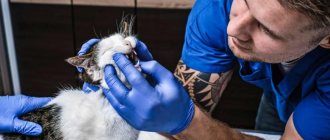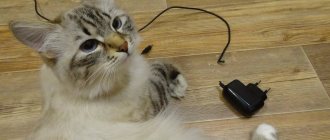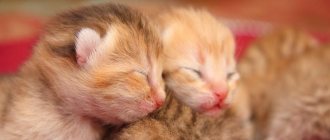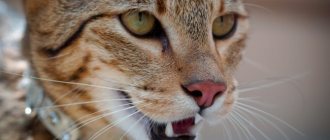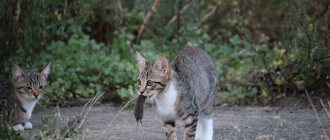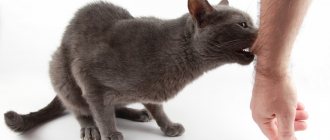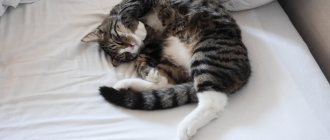When kittens change their milk teeth, owners should pay special attention to their little pet. In some pets, a similar process occurs at the age of 5-6 months, while in others, teeth change for about a year. In rare cases, in lop-eared kittens and representatives of other breeds, tooth replacement occurs painlessly. But often owners notice that when the baby gets new front teeth, the gums itch, there is pain and other unpleasant symptoms.
Owners are advised to contact a veterinarian, who, if necessary, will prescribe medications for the pet to facilitate the process of teething, and suggest other methods to eliminate discomfort.
Formation of primary dental occlusion
Almost all mammals are born toothless. Cats are no exception: the oral apparatus of a newborn kitten is maximally adapted for effective sucking. After all, the only food available to him is mother’s milk.
At two weeks of age, kittens develop milk teeth - straight, small, sharp, milky white. In adult cats they are powerful and curved. They are called milk teeth because they appear in kittens during breastfeeding.
Interesting! The front milk teeth of kittens are straight, and the fangs are curved.
Teething order
The eruption period lasts up to two months. By this age, the cat already has 26 baby teeth. They do not appear all at once, but in a certain order:
- 2–4 weeks. Incisors appear. First, 2 in the center of the jaw, then 4 more are added to them on both sides. There are 12 incisors in total - 6 each on top and bottom.
- 3–4 weeks. Fangs appear: 4 upper and 4 lower. They are located on the sides of the incisors.
- 4–8 weeks. The appearance of pre-masticating teeth - premolars: 4 on the lower jaw and 6 on the upper jaw.
Important! Milk teeth will serve kittens up to the age of 3-4 months with proper care and timely introduction of complementary foods.
Advice from a veterinarian-dentist
Removal of any fixed teeth, no matter whether they are temporary or permanent, must be carried out using anesthesia and analgesia. Dental pain is a moderate pain and proper analgesia is required for every patient.
To the question, is it possible to anoint the gums with something anesthetic or give them local anesthesia like in humans, I will answer right away - no, it is not possible.
Local analgesic gels will anesthetize the mucous membrane of the gums and tongue and increase salivation in the dog, which can lead to vomiting and aspiration of vomit into the trachea, and in cats their use is even more dangerous, since such gels can lead to laryngospasm and respiratory arrest. Unfortunately, a local injection into the gum cannot be carried out without the use of sedatives that induce sleep. I have a hard time imagining a cat or dog whose gum someone tries to stick a needle into. But even if this happened, after such an injection no patient will ever be allowed near him again.
Gil Veronika Yurievna, veterinarian, surgeon, dentist
https://gilvet.ru/stati/molochnye-zuby-u-sobak-i-koshek/
Captive temporary teeth, which are already being replaced by permanent teeth, are called persistent and must be removed at the first visible changes in the bite.
It is impossible to leave persistent teeth, because the dentition of an adult dog is designed for 42 teeth, and for a cat 30, and if there are more teeth, periodontitis will begin... The age for removing baby teeth is not a specific number. Everything happens individually for each animal, and to say, for example, that the optimal age is 8 months is wrong. Each animal has a different age for extraction; some require removal of persistent teeth as early as 5 months of age.
Gil Veronika Yurievna, veterinarian, surgeon
https://gilvet.ru/stati/molochnye-zuby-u-sobak-i-koshek/
In some puppies and kittens, the change of teeth occurs with an increase in body temperature and a decrease in appetite, sometimes even with a refusal to feed. In such situations, it is better to consult a doctor for help.
In cats, during the change of teeth, a very strong odor from the oral cavity is not a strong pathology, and if you see double rows of teeth (both permanent and temporary), know that this occurs normally. But if you notice that your permanent teeth are starting to grow and interfere with each other, you need to consult a specialist.
Gil Veronika Yurievna, veterinarian, surgeon, dentist
https://gilvet.ru/stati/molochnye-zuby-u-sobak-i-koshek/
If they removed temporary teeth and broke the crown, leaving the root in the gum with the words “it will resolve on its own,” I answer - no, it will not resolve.
Why should the root of a tooth dissolve because you have broken the crown? It will remain in the gums as a foreign body and at a certain time can cause the process of periodontitis of adjacent teeth or osteomyelitis of the jaw bones...
With any injury to the crown of a temporary canine, traumatic pulpitis occurs, and as a result, periodontitis develops with an abscess on the jaw, inside of which there is a rudiment of a permanent canine. Trauma, pain, inflammation and the possible loss of not only a temporary, but also a permanent canine - this is the price to pay for an incompetent attempt at self-medication.
In case of traumatic pulpitis of a temporary canine, the tooth must be immediately extracted (removed).
Gil Veronika Yurievna, veterinarian, surgeon, dentist
https://gilvet.ru/stati/molochnye-zuby-u-sobak-i-koshek/
If the temporary tooth is mobile and “almost transparent to the light”, there is no need to remove it at all - let the animal chew on something in which to sink the teeth (for example, a not very hard “chew” or a large treat), and, believe me, the tooth will fall out on its own .
Gil Veronika Yurievna, veterinarian, surgeon, dentist
gilvet.ru/stati/molochnye-zuby-u-sobak-i-koshek/
Video: cat dental care
Changing baby teeth to permanent ones
The replacement of baby teeth with permanent teeth in cats begins at 4 months. The formation of the masticatory apparatus is completed at 7–8 months. The time it takes for a permanent bite to develop may vary among different cat breeds. A slight advance or delay in deadlines is allowed.
Shift order
The location and order of changing baby teeth to permanent ones is clearly depicted in the figure below. The first to fall out are the deciduous incisors. Fangs change after complete replacement of incisors. Next comes the replacement of the premolars. After a complete change, 4 molars erupt - the main chewing ones. In the picture they are colored blue.
Types of permanent teeth
An adult cat should have a total of 30 teeth. For a cat, it is a weapon, a means of protection, defense and attack. Mother cats use their front incisors to gently grab and carry the kitten.
Interesting! In cats, the lower jaw can only move in a vertical plane, so it is incorrect to say that cats chew their food. They crush it, crush it into small pieces.
The table describes the location of cat teeth, their number and functional load.
| Upper jaw | Incisors – 6 | They serve to hold prey and tear off small pieces of food. | Fangs – 2 | Used for self-defense, capturing and chopping food | Premolars – 6 Molars – 2 | They grind the bones and crush large pieces. |
| Lower jaw | Incisors – 6 | Fangs – 2 | Premolars – 4 Molars – 2 |
Molars are located deep in the jaw. Their presence indicates that the cat has become an adult. During this period, he begins to mark his territory.
When your pet needs help
The help of a veterinarian is needed in the following cases:
- inflammation or ulceration of the oral mucosa - gingivitis, stomatitis;
- after a baby tooth falls out on the jaw, a non-healing wound forms in its place, sometimes with signs of purulent inflammation, which indicates periodontitis;
- disruption of the growth of a permanent tooth in the vicinity of an unfallen milk tooth; in this case, both a delay in the growth of a permanent tooth and a change in its position in the dentition are possible, while the tooth may begin to injure soft tissues, the formation of a malocclusion and even deformation of the bones of the facial skull with the formation of asymmetry of the muzzle. The formed double row of teeth contributes to the accumulation of plaque and the development of inflammatory diseases in the oral cavity, a complication of which can be osteomyelitis of the jaw bones with the formation of fistulas. It is recommended to remove a baby tooth in a veterinary clinic under anesthesia.
Unlike irritation, with gingivitis the redness and swelling of the mucous membrane are more pronounced; pus, pain, anxiety, depression, refusal to feed may appear
Symptoms of teething or changing teeth
By the behavior of kittens and the reaction of a nursing cat, you can understand that they are cutting their first teeth. The appearance of primary incisors is accompanied by swelling and soreness of the gums. The kitten is trying to get rid of unpleasant sensations, so during feeding it clenches its jaws with force and bites its mother's nipple.
Sharp incisors can injure the nurse. But this period does not last long and often goes unnoticed by the owners.
By the end of the 4th month, the rudiment of a permanent tooth is formed in the gums of the upper and lower jaws under each milk tooth. As it grows, baby teeth shift, are pushed out of the gums and fall out one by one. This occurs at approximately 5 months.
Replacing baby teeth with permanent ones causes noticeable changes in the kitten's behavior. During this time, your pet's condition should be monitored to help if complications arise.
Symptoms of teeth changing in kittens:
- When young cats lose their baby teeth, they become biters in an attempt to get rid of itchy gums. You should not allow the kitten to bite the owner's hands. It will be very difficult to re-educate him later.
- Excessive salivation appears - ptyalism. This is how nature protects delicate gums from possible inflammation.
- An unpleasant odor appears from the mouth. The reason is moderate inflammation.
- Possible increased body temperature, lethargy or agitation, aggression. This is a reason to contact a veterinarian.
- Kittens lose their appetite or refuse solid food because their swollen, inflamed gums are painful to chew. Dry food should be removed from the diet, leaving only soft food.
Important! When kittens change teeth, it is necessary to exclude the animal from access to anything that could harm it. For example, when chewing wooden surfaces, a cat can hurt its gums.
To make the teething process go smoothly, you can purchase special “chewing” toys.
Lost primary incisors can be discovered by the owner during play. But most often kittens swallow them while eating. This is normal - everything will work out naturally.
Care and feeding
Changes in teeth in cats can make themselves felt as early as six months later, so owners should know how to properly care for their pet so that the process goes faster and less painfully. It is important to monitor the behavior of British cats and representatives of other breeds, preventing them from chewing furniture, shoes and other objects in the house. As a relief, the kitten is capable of biting the owner's fingers or toes, but this should not be allowed, since the habit can become a serious problem in the future. During the period of teeth change, it is worth observing a special diet, adhering to the following recommendations:
To ensure a sufficient amount of calcium for the animal’s body, it is recommended to include cottage cheese in its diet.
- Avoid very soft food, since the kitten may inadvertently swallow lost teeth, resulting in damage to the esophageal mucosa. It is recommended to introduce food of coarse consistency and large size into the diet.
- The meat is given in large pieces, with preference given to beef, turkey, and chicken. You first need to scald or boil it.
- Add cottage cheese and other fermented milk products, which contain a lot of calcium, to your daily diet.
- It is possible to add drops or small tablets of phosphorus to the main diet. It is possible to purchase such drugs at a veterinary pharmacy, and many of these drugs contain a small analgesic substance that eliminates pain when changing teeth.
- Twice a week the kitten is fed boiled sea fish, for example, hake.
- The diet is replenished with foods filled with vitamins A and D.
- It is recommended to let the kitten chew on special bones, which are previously purchased at a pet store. They consist of vitamin supplements, thanks to which you can not only scratch your gums and strengthen your growing teeth, but also get the necessary vitamins.
Possible complications
The eruption of baby teeth and their replacement with permanent teeth are natural processes of growth for any animal. They must take place on time. It is necessary to contact a veterinarian in time if complications arise:
- The kitten has been sleeping poorly for the last 24 hours, not eating, restless, and meowing.
- The unpleasant odor does not go away for a long time, it becomes pungent - periodontal disease may develop.
- Excessive secretion of saliva and its thickening - the likelihood of gingivitis or stomatitis.
In order not to miss alarming symptoms when cats change teeth, you need to regularly examine the oral cavity.
Gum inflammation
A healthy cat's gums should be pale pink and free of swelling. During eruption, swelling, redness, slight swelling and short-term bleeding are allowed. These phenomena quickly pass: the swelling quickly subsides, the hole in the place of the lost tooth heals without a trace.
You should not postpone a visit to the veterinarian if:
- inflammation has occurred around the baby tooth;
- Reddened gums bleed for a long time;
- pus appears on the gums or in the sockets;
- the baby incisor is “slanted” and injures the gums, this usually happens with fangs.
All of these signs are symptoms of periodontal disease, stomatitis, and gingivitis. Purulent inflammations are especially dangerous.
Interesting! Scottish Fold cats are the most prone to gum disease. The owners of Scottish dogs should be especially attentive to them during this difficult period.
Residual baby teeth
Usually the new tooth grows in its own socket. Therefore, it often happens that a permanent one grows next to a milky one that has not yet fallen out. This is the norm, but if a baby tooth does not fall out in 8 months, this is a reason to consult a doctor.
An anomaly, when permanent teeth have already erupted, but milk teeth have not yet fallen out, is rare. In this case, a double dentition is formed and, as a result, an incorrect bite. In this case, the oral mucosa, the inside of the cheeks, and the kitten’s tongue are injured.
If more than one or two primary incisors remain in the pet's jaw, surgical intervention and strict monitoring of the subsequent eruption process are inevitable.
Expert opinion
Chepa Natalya Semenovna
Veterinarian
Ask an expert
In some cases, kittens may develop juvenile gingivostomatitis after teething. This is an inflammation of the gums that develops after the appearance of permanent teeth. Young cats under 2 years of age are affected. The exact causes of the inflammatory process have not been fully established. The disease probably occurs against the background of an allergic reaction of the body to plaque bacteria. Some breeds have a predisposition: Maine Coons, Sphynxes, Bengals, Orientals. Characteristic signs of juvenile gingivostomatitis are bad breath, redness and swelling of the gums. To treat the disease, sanitation of the oral cavity with antiseptics, for example, Miraxidin solution, is prescribed. In difficult cases, ultrasonic teeth cleaning may be required. To prevent the disease, it is recommended to brush your pet’s teeth with special pastes for animals. Moreover, it is better to accustom your cat to the procedure from childhood.
Why do new teeth emerge?
Just like in humans, kittens 4 months and older gradually replace their milky bone tissue with permanent teeth. Many owners get scared when they notice that the cat is missing one tooth or is constantly scratching its lips and gums. There is no need to worry, since such a process is completely natural and necessary. It is only important to ensure that the animal grows a new set of teeth normally and does not have double teeth, in which two teeth immediately fall out in place of one tooth. Contacting a veterinarian is also necessary in other cases:
- the resulting wounds fester and heal for a long time;
- inflammatory reaction in the gum area.
Oral care
To maintain healthy teeth for your pets, you need to follow three basic rules:
- From an early age, it is necessary to provide the kitten with a healthy, balanced diet, sufficient amounts of minerals and vitamins. The veterinarian will help you choose food in accordance with the age and physiological characteristics of the cat. Cleaning of the incisors occurs naturally: when the animal chews solid food. That’s why the presence of dry food and large pieces in a cat’s diet is so important. Mechanical action on the surface of the teeth cleanses them of plaque and protects them from the formation of tartar.
- Compliance with the rules of basic oral hygiene. The list of kitten care procedures should include mandatory cleaning. Baby teeth can be cleaned with a soft cloth. The kitten will enjoy this procedure if a special paste for cats is applied to the fabric - it has a pleasant smell and taste. Changing incisors can be cleaned with a brush: the kitten will happily chew on the soft bristles, which will help cope with the itching. As your permanent teeth grow in, you can move on to brushing with a stiffer bristled brush. The procedure is carried out with light movements from roots to ends. Regularity – 2–3 times a week.
- Constant availability of sufficient clean water.
If tartar or other pathologies appear, you should contact your veterinarian. The treatment takes place under anesthesia, so there is no need to worry about the moral and emotional state of your pet.
Self-examinations conducted by the owner and regular visits to the veterinarian will help raise a strong, beautiful pet and maintain the health of its teeth for a long time. Regularity is important - this will allow you to identify problems in time and help the animal.
What to do and how to relieve the kitten’s discomfort?
It is recommended to buy special chewing toys for the kitten during the change of teeth.
When pets change their teeth, they often experience pain that does not allow them to live their previous lives. If a cat’s fang or molars are protruding, then to alleviate the discomfort, owners are advised to purchase special rodents or bones from the pet store, on which the animal can scratch its gums. For this reason, as soon as a kitten’s tooth falls out, it is worth removing all electrical appliances, shoes and other items that the baby can damage. If a cat experiences increased salivation when changing teeth, then no measures should be taken. In most cases, this symptom does not cause discomfort to the kitten. If his face is constantly wet, then periodically it can be wiped with a soft cloth or dry cloth.
When a kitten's teeth grow, its body may be constantly in a state of stress. Owners are advised to treat the baby with special attention, surround him with love, care and attention. Frequent contact with your pet and various games will distract him from changing teeth and reduce discomfort. During this process, the pet often rubs against the corners of furniture or the owner’s legs. You shouldn’t forbid him to do this, because with such actions he is trying to calm himself down and scratch his gums. It is also important to pay attention if these signs are not observed, as they may indicate a problem, so it is recommended to take the kitten to the vet.
General information
A sign of a “full” mouth is the desire of babies to chew something, starting from their paws and ending with the owner’s feet. This period should be accompanied by the closest monitoring of the kittens, properly organized nutrition, and dental care.
By 1.5-2 months, kittens have a full milk set, consisting of incisors, canines and molars. There comes a transition from sucking to the chewing period. The peculiarity of the replacement teeth is their thinness and whiteness in comparison with the molars.
By 3-5 months, baby teeth are replaced by permanent ones; the owners, due to the painlessness of the process, do not notice this process. The formation of the dentition is completed by 7-8 months of age. The gums remain pink and smooth, without stones and deposits of a creamy white or milky tone.
When kittens change teeth, symptoms may appear: increased drooling, short sleep, refusal to eat, unpleasant odor. If they appear, you should consult a specialist.
Changes in the well-being and behavior of kittens
Teeth germination is painless, but is accompanied by severe itching. The animal scratches its gums: gnaws on inedible objects, bites the owner’s fingers, rubs its muzzle with its paw on the edges of furniture.
At the same time, the following natural changes are noticed:
- A repulsive odor appears from the mouth, because inflammation cannot be avoided. It goes away a month after growth is complete.
- Salivation increases during play and feeding; this is a protective reaction against inflammation of the mucous membranes of the mouth.
- The site where the next tooth appears swells and recovers 1 – 2 days after eruption.
- The animal eats worse, but does not completely lose its appetite.
- Sometimes the temperature rises to 39.5℃, the kitten looks for a warm place and lies down under the blanket.
- Bleeding after prolapse does not exceed 3 minutes.
Milk and molar teeth emerge from different sockets, so often a new one emerges when the temporary one has not yet fallen out. This phenomenon does not require intervention if they do not touch each other, there are no signs of inflammation on the gums, and the period for replacing teeth has not yet passed. Animals are not vaccinated until their bite is formed: their immunity weakens and they become more vulnerable to infections.
This is interesting: Eliminate cat odor
Causes of tooth loss in adult cats
If teeth fall out in adult cats, this is a clear sign of pathology. The most common cause is injury. A cat gets them when he tries to chew on inedible objects, crashes into furniture while playing, or fights with other animals. Injury can be caused by a person trying to pull out an object stuck in the teeth or take away prey.
Other causes of tooth loss:
- inflammatory gum diseases;
- pathologies of the immune system;
- diabetes;
- tumor lesions;
- hormonal imbalances.
If your cat's teeth fall out, you need to contact a veterinarian; this is always a sign that the animal is unhealthy.
Prevention of hair loss
To avoid tooth loss, you need to avoid creating traumatic situations and comprehensively monitor your cat’s health and diet. Ready-made super-premium food is preferred. Natural food is only useful when it is perfectly balanced to suit the cat’s needs, and this requires time and labor.
If a piece of food is stuck in a cat's teeth, remove it carefully, without loosening it and without sudden jerks. If this is not possible, it is better to consult a veterinarian.
In order to notice negative changes in time, your pet needs to be taken to the veterinarian for an examination every year. This is a comprehensive procedure that allows you to assess your general health and notice the onset of chronic diseases.
Situations where cats harm each other should not be allowed. Fights between pets should not be encouraged; on the contrary, they need to be separated and relationships between the tailed animals should be established. If a fang falls out in a fight, it will be difficult for the cat to eat and defend its place in feline society.
